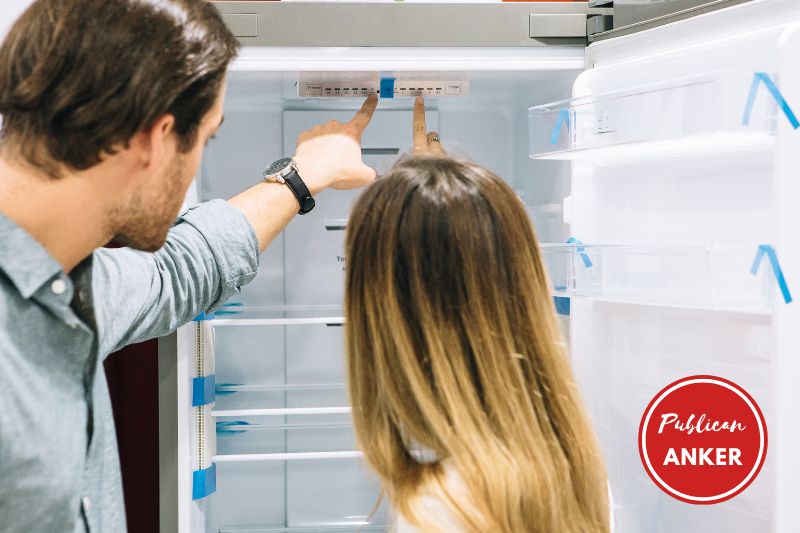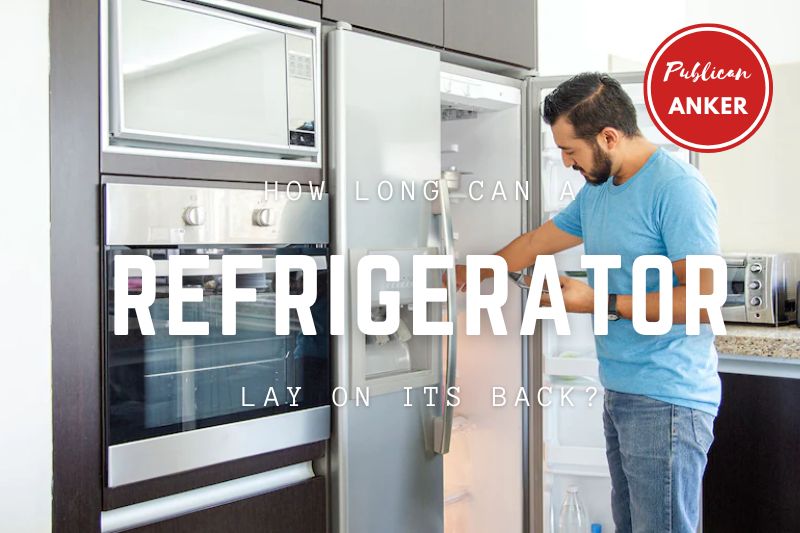A refrigerator is an essential appliance in our daily lives to keep our food fresh and safe to consume. However, there may be instances where we need to transport or move our fridge, which raises questions about its orientation during transit. Specifically, many people wonder how long can a refrigerator lay on its back without causing damage.
Laying a refrigerator on its back can potentially damage the compressor, which regulates the temperature inside the fridge.
Can You Lay A Fridge On Its Back

Laying fridge on its back is generally not recommended, as it can damage the compressor and other internal components. When transported, a refrigerator should remain upright to prevent any potential damage.
If the fridge needs to be moved in a horizontal position, it should be tilted only slightly and never completely laid flat on its back.
This is because laying the fridge on its back can cause the compressor oil to flow into the refrigeration lines, which can cause blockages and damage to the compressor.
In short, it is best to avoid laying a fridge on its back and transport it upright whenever possible.
How Long Can a Refrigerator Lay on Its Back?

Laying a refrigerator on its back can cause significant damage to the appliance, and it is not recommended. However, if it is necessary to lay a fridge on its back, it should be done as quickly as possible.
This is because laying a refrigerator on its back can cause the compressor oil to flow into the refrigeration lines, leading to blockages and damage to the compressor. The longer the fridge remains in this position, the greater the risk of damage.
If a refrigerator needs to be laid on its back for some reason, it should be done for no longer than 15-20 minutes. This will minimize the risk of damage to the compressor and other internal components.
It is worth noting that refrigerators should be transported upright whenever possible to prevent damage to the appliance. If it is necessary to transport refrigerator on back, it should be tilted only slightly and never laid completely flat on its back.
What Happens When You Lay Refrigerator on Its Side and Back?

While this may seem like a straightforward process, it can cause significant damage to the refrigerator’s internal components when transporting a refrigerator on its back. This article will discuss what happens when you lay a refrigerator on its side and back.
Spilt Water
When you lay a refrigerator on its back and side, any standing water or melted ice inside the freezer may spill onto the floor.
This can cause damage to your flooring or create a safety hazard if someone slips and falls. Additionally, any water that leaks into the compressor area can cause damage to the electrical components and lead to a malfunctioning refrigerator.
The Compressor Oil Moves
The compressor is the heart of the refrigerator, responsible for cooling the unit. When you lay the refrigerator on its side or back, the compressor oil may move away from its necessary parts, causing it to malfunction.
This is because the oil is a lubricant to the compressor’s internal parts, ensuring they run smoothly. If the oil is not in the right place, it can cause the compressor to wear down quickly and even fail.
Damage to the Back Panel
The back panel of a refrigerator is an essential component that helps keep the unit functioning correctly. When you lay the refrigerator on its back or side, the back panel can become warped or damaged, leading to problems with the refrigerator’s insulation.
This can cause the unit to lose its ability to cool properly, leading to spoiled food and higher energy bills.
Shelving May Break
Refrigerator shelves are designed to hold a specific amount of weight and are typically designed to withstand the weight of food and other items stored inside the fridge.
However, when you lay the refrigerator on its side or back, the shelves’ weight distribution changes, causing stress on specific points that can cause them to break or warp.
The Compressor Components May Dislodge
The compressor comprises several internal components that work together to cool the refrigerator. When you lay the refrigerator on its side or back, these components can become dislodged, leading to compressor damage.
The compressor’s delicate components can break easily, leading to expensive repair bills or replacing the entire unit.
Which Side Do You Lay a Fridge Down?

First and foremost, it’s crucial to unplug the fridge and remove all the contents before attempting to move it. This includes any shelves, drawers, and other removable parts. Once everything is removed, the fridge should be secured properly for transport.
When laying a fridge down, keeping it in the same position as it would be when standing upright is essential. This means that the back of the fridge should always be facing down, and the front should be facing up.
This is because the compressor and refrigerant lines are located at the bottom of the fridge, and laying it down on its back or side can cause damage to these components.
Additionally, it’s important to avoid tilting the fridge too much when laying it down. Ideally, the fridge should be laid down gently and kept as level as possible. Tilting the fridge too much can cause the oil from the compressor to leak out, leading to compressor failure.
If you must lay the fridge down on its side, choosing the right side is important. Generally speaking, it’s best to lay the fridge on its left side, with the door facing up.
This is because the refrigerant lines are located on the right side of the fridge, and laying it down on that side can cause damage to these components. The refrigerant lines are kept from potential damage by laying the fridge down on its left side.
What to Do After Transporting a Fridge on Its Side

Transporting a fridge on its side is not recommended, as it can cause damage to the compressor and other internal components. However, it may be necessary to transport a fridge horizontally due to space constraints or other logistical issues.
If you find yourself in this situation, there are certain steps you can take to minimize the risk of damage and ensure that the fridge continues to function properly.
Let the fridge sit upright for at least 24 hours
After transporting a fridge on its side, it is important to let it sit upright for at least 24 hours before turning it on. This allows any oil that may have migrated from the compressor to drain back into place.
Turning the fridge on immediately after transportation can cause the compressor to run without enough oil, damaging the compressor and other internal components.
Clean the fridge
Before turning the fridge on, it is a good idea to clean it thoroughly. This will not only help to remove any dirt and debris that may have accumulated during transportation, but it will also help to prevent any potential health hazards that could arise from bacteria or mold growth. Use a gentle cleaner and warm water to wipe down the interior and exterior of the fridge, including the door seals, shelves, and drawers.
Check the door seals
After cleaning the fridge, it is important to check the door seals to ensure they are still intact and working properly. If the door seals are damaged or not sealing properly, it can cause the fridge to work harder and not cool properly.
Check for any signs of damage or wear and tear, such as cracks or gaps. If the seals are damaged, they will need to be replaced.
Check the temperature
Once the fridge has been allowed to sit upright for 24 hours, you can turn it on and check the temperature. Ensure the temperature settings are correct and the fridge is cooling properly.
You can use a thermometer to check the temperature inside the fridge and adjust the temperature settings if necessary. It is important to note that the fridge may take several hours to cool down to the desired temperature.
Monitor the fridge for the first few days
After turning the fridge on, monitoring it closely for the first few days is important to ensure it is working properly.
Check the temperature regularly, and listen for any unusual sounds or vibrations. If you notice any issues, such as the fridge not cooling properly or strange noises, it may be necessary to call a professional to come and inspect the fridge.
Keep the fridge properly maintained
To prevent any future issues with your fridge, it is important to keep it properly maintained. This includes cleaning it regularly, checking the door seals, and having it serviced by a professional regularly. By keeping your fridge in good condition, you can ensure that it continues to function properly and lasts for many years.
Read more:
- How To Remove Ice Maker From Samsung Refrigerator 2023
- Best Refrigerator Under 2000: Top Brands Review [2023]
FAQs about Can A Refrigerator Be Transported On Its Back

How long can a refrigerator lay on its side?
Ideally, a refrigerator should not be on its side for more than 1-2 hours. When a fridge is laid down, the oil from the compressor can begin to settle in the wrong place, leading to compressor failure when the fridge is turned back upright.
If you need to lay a fridge down for an extended period, it’s essential to keep it as level as possible and limit the time it spends in that position.
How long can a freezer lay on its side?
A freezer should not be laid on its side for more than 1-2 hours like a refrigerator. If a freezer is left on its side for too long, the oil from the compressor can settle in the wrong place, leading to compressor failure when the freezer is turned back upright.
Does it ruin a refrigerator to lay it down?
Laying a refrigerator down can potentially damage the compressor and refrigerant lines, which can cause issues with the fridge’s cooling ability.
Additionally, tilting the fridge too much can cause the oil from the compressor to leak out, leading to compressor failure. If you must lay a fridge down, following the proper procedure and keeping it as level as possible is essential.
Can new refrigerators be laid down?
Yes, new refrigerators can be laid down if necessary, but following the proper procedure is important to avoid damaging the fridge. The fridge should be unplugged, and all contents should be removed before attempting to move it.
The fridge should be laid on its left side, with the door facing up, and kept as level as possible. Limiting the amount of time the fridge spends in this position and lifting it back upright carefully is important.
Can I lay my fridge on its side for 30 minutes?
If you absolutely need to lay your fridge on its side for transportation or other reasons, it is recommended to do so for as short a time as possible and then allow it to stand upright for at least 4-6 hours before plugging it in and turning it on. This will allow the oil to settle back to its proper location in the compressor.
Conclusion
When moving a refrigerator, following the proper procedure is essential to avoid damaging the compressor and refrigerant lines. While a fridge should always be transported in an upright position, there are some situations where laying it down may be necessary.
If you must lay a fridge down, it’s crucial to unplug it, remove all contents, and choose the right side. The back of the fridge should always be facing down, and the front should be facing up.
It’s best to lay the fridge down on its left side, with the door facing up, to keep the refrigerant lines away from potential damage. Additionally, it’s important to keep the fridge as level as possible and limit the time it spends in this position.
Finally, thank you for reading this article on how long can a fridge be on its side and back, don’t forget to visit Publicananker to stay updated.
